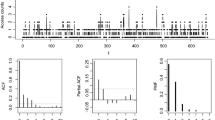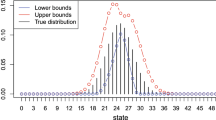Abstract
To model zero-inflated time series of counts, we propose a first-order mixed integer-valued autoregressive process with zero-inflated generalized power series innovations. These innovations contain the commonly used zero-inflated Poisson and geometric distributions. Strict stationarity, ergodicity of the process, and some important probabilistic properties such as the transition probabilities, the k-step ahead conditional mean and variance are obtained. The conditional maximum likelihood estimators for the parameters in this process are derived and the performances of the estimators are studied via simulation. As illustration, an application to an offence data set is given to show the effectiveness of the proposed model.
Similar content being viewed by others
References
Al-Osh, M. A., & Alzaid, A. A. (1987). First-order integer-valued autoregressive (INAR(1)) process Journal of Time Series Analysis, 8, 261–275.
Alzaid, A. A., & Al-Osh, M. A. (1988). First-order integer-valued autoregressive (INAR(l)) process: distributional and regression properties. Statistica Neerlandica, 42, 53–61.
Alzaid, A. A., & Al-Osh, M. A. (1993). Some autoregressive moving average processes with generalized Poisson marginal distributions. Annals of the Institute of Statistical Mathematics, 45, 223–232.
Bu, R., McCabe, B., & Hadri, K. (2008). Maximum likelihood estimation of higher-order integer-valued autoregressive processes. Journal of Time Series Analysis, 29, 973–994.
Drost, F. C, Akker, R. V. D., & Werker, B. J. (2009). Efficient estimation of auto-regression parameters and innovation distributions for semiparametric integer-valued AR(p) mode Is. Journal of the Royal Statistical Society. Series B (Statistical Methodology), 71, 467–485.
Du, J. C, & Li, Y. (1991). The integer-valued autoregressive (INAR(p)) model. Journal of Time Series Analysis, 12, 129–142.
Fokianos, I. C. (2011). Some recent progress in count time series. Statistics, 45, 49–58.
Fox, J. P. (2013). Multivariate zero-inflated modeling with latent predictors: modeling feedback behavior. Computational Statistics and Data Analysis, 68, 361–374.
Grunwald, G. K., Hyndman, R. J., Tedesco, L, Stweedie, R. L. (2000). Non-Gaussian conditional linear AR(1) models. Australian and New Zealand Journal of Statistics, 42, 479–495.
Gupta, P. L, Gupta, R. C, & Tripathi, R. C. (1995). Inflated modified power series distributions with applications. Communications in Statistics-Theory and Methods, 24, 2355–2374.
Jazi, M. A., Jones, G., & Lai, C. D. (2012). First-order integer valued AR processes with zero inflated Poisson innovations. Journal of Time Series Analysis, 33, 954–963.
Latour, A. (1998). Existence and stochastic structure of a non-negative integer-valued autoregressive process. Journal of Time Series Analysis, 19, 439–455.
McCabe, B. P., Martin, G. M., & Harris, D. (2011). Efficient probabilistic forecasts for counts. Journal of the Royal Statistical Society. Series B (Statistical Methodology), 73, 253–272.
Nastic, A. S., & Ristic, M. M. (2012). Some geometric mixed integer-valued autoregressive (INAR) models. Statistics & Probability Letters, 82, 805–811.
Ospina, R., & Ferrari, S. L. P. (2012). Ageneral class of zero-or-one inflated beta regression models. Computational Statistics and Data Analysis, 56, 1609–1623.
Perumean-Chaney, S. E., Morgan, C, McDowall, D., & Aban, I. (2013). Zero-inflated and overdispersed: what’s one to do? Journal of Statistical Computation and Simulation, 83, 1671–1683.
Ridout, M., Demétrio, C. G. B., & Hinde, J. (1998). Models for count data with many zeros. In ’Proceedings of the 19th international biométrie conference.’, Cape Town, South Africa (pp. 179–190).
Ristic, M. M., Bakouch, H. S., & Nastic, A. S. (2009). A new geometric first-order integer-valued autoregressive (NGINAR(1)) process. Journal of Statistical Planning and Inference, 139, 2218–2226.
Ristic, M. M., & Nastic, A. S. (2012). A mixed INAR(p) model. Journal of Time Series Analysis, 33, 903–915.
Schweer, S., & Weill, C. H. (2014). Compound Poisson INAR (1) processes: Stochastic properties and testing for overdispersion. Computational Statistics and Data Analysis, 77, 267–284.
Silva, M. E. D., & Oliveira, V. L. (2004). Difference equations for the higher-order moments and cumulants of the INAR (1) model. Journal of Time Series Analysis, 25, 317–333.
Staub, K. E., & Winkelmann, R. (2013). Consistent estimation of zero-inflated count models. Health Economics, 22, 673–686.
Tjøstheim, D. (2012). Some recent theory for autoregressive count time series. TEST, 21, 413–438.
Wang, Z. K. (1982). Stochastic process. Beijing: Scientific Press.
Wang, D., & Zhang, H. (2011). Generalized RCINAR(p) process with signed thinning operator. Communications in Statistics. Simulation and Computation, 40, 13–44.
Weil, C. H. (2008). Thinning operations for modeling time series of counts-a survey. Advances in Statistical Analysis, 92, 319–341.
Welsh, A. H., Cunningham, R. B., Donnelly, C. F., & Lindenmayer, D. B. (1996). Modelling the abundance of rare species: statistical models for counts with extra zeros. Ecological Modelling, 88, 297–308.
Zhang, H., Wang, D., & Zhu, F. (2010). Inference for INAR(p) processes with signed generalized power series thinning operator. Journal of Statistical Planning and Inference, 140, 667–683.
Zhang, H., Wang, D., & Zhu, F. (2012). Generalized RCINAR(l) process with signed thinning operator. Communications in Statistics-Theory and Methods, 41, 1750–1770.
Zhu, F. (2012). Zero-inflated Poisson and negative binomial integer-valued GARCH models. Journal of Statistical Planning and Inference, 142, 826–839.
Zhu, R., & Joe, H. (2006). Modelling count data time series with Markov processes based on binomial thinning. Journal of Time Series Analysis, 27, 725–738.
Author information
Authors and Affiliations
Corresponding author
Rights and permissions
About this article
Cite this article
Li, C., Wang, D. & Zhang, H. First-order mixed integer-valued autoregressive processes with zero-inflated generalized power series innovations. J. Korean Stat. Soc. 44, 232–246 (2015). https://doi.org/10.1016/j.jkss.2014.08.004
Received:
Accepted:
Published:
Issue Date:
DOI: https://doi.org/10.1016/j.jkss.2014.08.004




